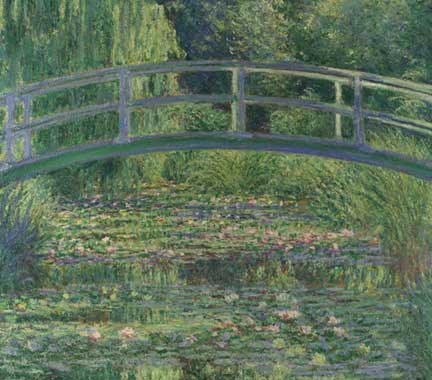Major Characteristics of the 20th Century

One of the most famous works that sound like the ocean is Claude Debussy's "La Mer." Debussy was a French impressionist, largely influenced by Eastern music. In fact, much of the music that he wrote incorporated musical elements from the East. For example, Debussy used the whole tone scale (a particularly "spacy" sounding scale") when he wrote.
Close your eyes when you listen to "La Mer". You can hear the sound of the waves crashing, of thunder, and of giant ships being tossed about. Debussy created these sounds by using clever orchestration. Orchestration is simply choosing which instrument should play a certain part. For example, a melody might sound better with the flute than with the tuba.
Listen to Debussy's "La Mer." What instruments make the wave sounds? What do you think about when you hear this piece?
Listening Link: Debussy's La Mer performed by the London Symphony
Modernism

Technology
1877 Edison Invented the Cylinder disk, and by 1897, records began to radically change the way music was heard by listeners. Eventually, radio, TV, computers, and the internet all changed the way that music was heard, sold, distributed, and stored.
Diversity and Globalization
The 20th Century saw the world grow much smaller, and greater acceptance of cultural diversity. From the World Fair in 1889, which inspired Impressionist Composer Claude Debussy to write music based on the Javanese Gamelan, to increased technological wizardry through live cross-Atlantic electronic video concerts with Pauline Oliveros, the world grew increasingly smaller as technology and transportation improved.
Another exciting development in 20th century included increases in women's education, which allowed many talented women to pursue their love of music professionally. Previous to this time period, a talented musician (like Mozart's equally talented sister Maria or Mendelssohn's sister Fanny) was not allowed to pursue her musical career because her duty was to marry well. There are notable exceptions to this rule (Barbara Strozzi or the nun Hildegard von Bingen), but generally, women are not recognized for their musical achievements until the late 1800s.
Amy Beach "Gaelic Symphony"
http://www.youtube.com/watch?v=Xc6dCsmKxXM
Jazz
African-American music in the US gave birth to an exciting new musical style: Jazz, a unique blend of European and African musical styles. Borrowing from the spirituals, ragtime, blues, and traditional European art music, Jazz took the 20th century by storm, with talented composers like Scott Joplin, Duke Ellington, Gershwin, and Leonard Bernstein creating classical works with jazz influence.
Maple Leaf Rag by Scott Joplin
Satin Doll by Duke Ellington
http://www.youtube.com/watch?v=SDDCzb3dv_Y
http://www.youtube.com/watch?v=xkdP02HKQGc&feature=related
Gershwin Rhapsody in Blue
http://www.youtube.com/watch?v=IEpdXgj94xE&feature=related
Gershwin Porgy and Bess
http://www.youtube.com/watch?v=O7-Qa92Rzbk
MUSICALS & Film
As we are exploring the 20th century and beyond this week, it would be remiss not to mention the importance of the musical in the 20th century. A musical and an opera, while both large musical productions, can sometimes be difficult to distinguish. The American Musical actually finds its birthplace more in vaudeville than in classical music. How? The innovation of adding sound to film suddenly allowed popular vaudeville acts to gain a new audience through film. Now they could perform for thousands of people without having to travel as extensively. Because of this, the first musicals in the US often were closer to variety acts than actual performances with plots.
However, as time (and film) brought the genre to the forefront, the plots became more substantial and attempted to make a statement, instead of just provide mediocre entertainment.
Contemporary musicals, like Rent, attempt to combine great music with a message. Cartoons helped with the resurgence of musicals. Disney especially had a series of musicals like The Little Mermaid and Beauty and the Beast (which won an Oscar for best film) that experienced great success. And film reprisals, like the award-winning Chicago, have helped keep the genre alive.
Andrew Lloyd Webber's Phantom of the Opera remains to be one of the most impressive musicals of our time. It stands along with other great musicals like Les Miserables, Porgy and Bess (sometimes considered an opera), and Leonard Bernstein's West Side Story.
Chicago
http://www.youtube.com/watch?v=4Spy3Nd2D6w
Shower Scene from Psycho
http://www.youtube.com/watch?v=8VP5jEAP3K4&feature=related
http://www.youtube.com/watch?v=tUcOaGawIW0



Comments